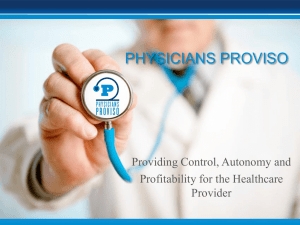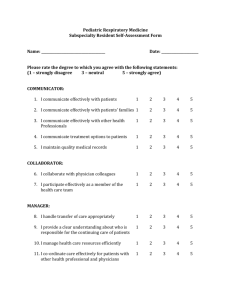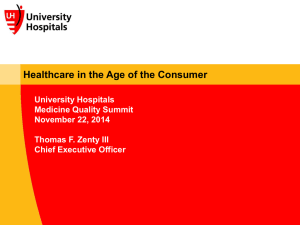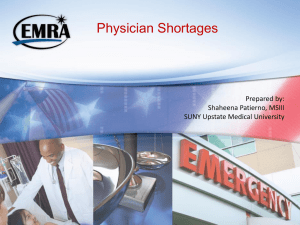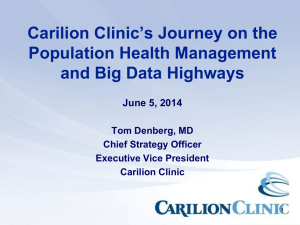Yang ZJ MD1 *, Cape HR MD2 - University of Toronto Medical Journal
advertisement
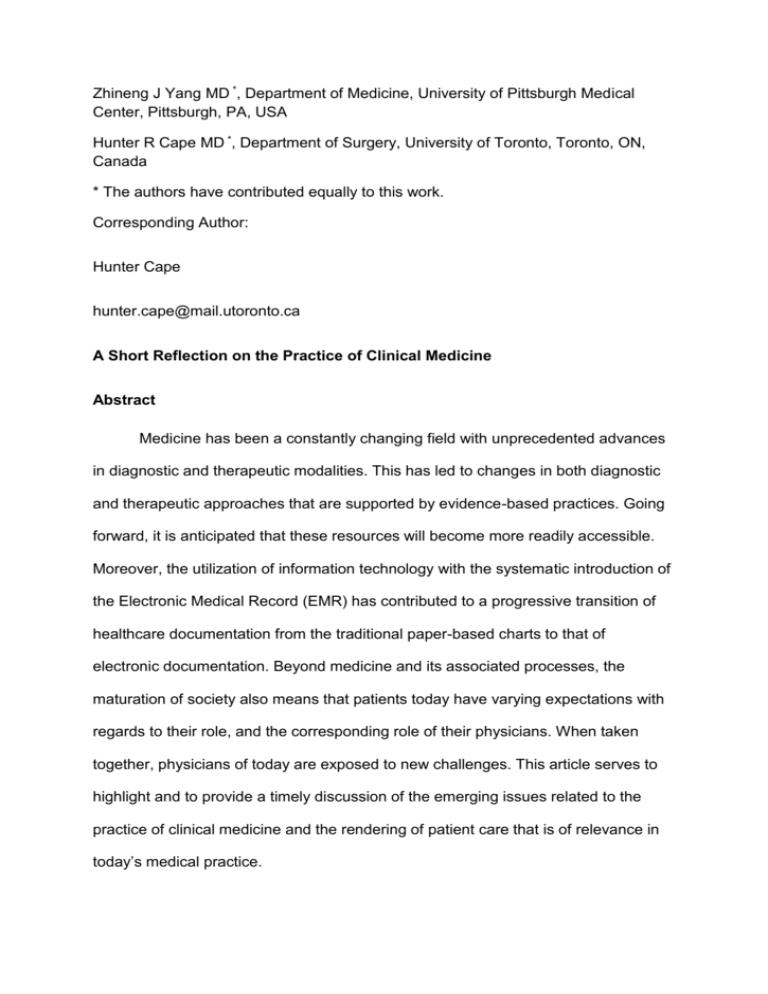
Zhineng J Yang MD *, Department of Medicine, University of Pittsburgh Medical Center, Pittsburgh, PA, USA Hunter R Cape MD *, Department of Surgery, University of Toronto, Toronto, ON, Canada * The authors have contributed equally to this work. Corresponding Author: Hunter Cape hunter.cape@mail.utoronto.ca A Short Reflection on the Practice of Clinical Medicine Abstract Medicine has been a constantly changing field with unprecedented advances in diagnostic and therapeutic modalities. This has led to changes in both diagnostic and therapeutic approaches that are supported by evidence-based practices. Going forward, it is anticipated that these resources will become more readily accessible. Moreover, the utilization of information technology with the systematic introduction of the Electronic Medical Record (EMR) has contributed to a progressive transition of healthcare documentation from the traditional paper-based charts to that of electronic documentation. Beyond medicine and its associated processes, the maturation of society also means that patients today have varying expectations with regards to their role, and the corresponding role of their physicians. When taken together, physicians of today are exposed to new challenges. This article serves to highlight and to provide a timely discussion of the emerging issues related to the practice of clinical medicine and the rendering of patient care that is of relevance in today’s medical practice. Introduction Medicine is a profession that is steeped in tradition where physicians are responsible for self-regulation, guidance, continued training and for setting the pace and mood of tomorrow’s medical practice. Furthermore, to remain relevant the practice of medicine has to adapt and improvise to meet the needs of modern society. Effective delivery of healthcare will be dependent on how current issues in clinical practice are being addressed, the resiliency of the medical profession to improve on the current standard of practice, as well as its ability to make relevant changes. The medical landscape has changed considerably over the past century. Propagated by technological advances, the boundaries of medicine, whether in the areas of screening, diagnostic or therapeutic modalities, continue to be skirted at an exceptional rate. Central themes to the delivery of contemporary medicine include the evolution of the doctor-patient relationship from one of a paternalistic physician centered model into a patient centered one structured around a Multidisciplinary Team (MDT) approach. This model is applicable to the delivery of care in both the inpatient and outpatient setting. Furthermore, with the advent of the Electronic Medical Record (EMR) and the wealth of information available through investigatory and diagnostic testing, the resources to deliver an exceptional standard of care are clearly available. However, with increasing access to new resources comes the responsibility to use them appropriately and in a manner that is acceptable to both the economic climate and society as a whole. This article will serve to highlight these issues and aim to underline their associated pitfalls. The following paragraphs will go on to define important issues that have key relevance to every practicing physician. Multidisciplinary Team vs. Independent Practice The escalating knowledge base in medicine has given way to increased specialization and sub-specialization throughout all fields. Coupled with an aging population, often with multi-organ illnesses, it is not unusual for patients to be managed by multiple physicians, each looking after a specific system. The days where one primary physician manages most of a patient’s medical issues are quickly being replaced by consultative medicine involving multiple inputs from subspecialty colleagues. This includes allied health professionals such as dieticians, nurse practitioners, physical therapists, case managers and social workers. The MDT approach has been shown to be valuable in certain settings. For example, Landefeld et al. found in a randomized control trial that by using the MDT approach to apply principles of quality improvement and comprehensive geriatric assessment to develop a new system of care for acutely ill elderly patients, that they were able to improve the ability of this patient population to perform basic activities of daily living at the time of discharge as well as reduce the frequency of discharge to institutions for long-term care 1. Likewise, published data by Cohen et al. supported the utility of MDT approach in the geriatric setting, and further suggest that there is also benefit when used in the outpatient setting 2. Another obvious benefit of the MDT has been in the field of oncology whereby increasing specialization and complexity of cases is routinely shared across the fields of medical oncology, surgical oncology, radiology and pathology 3, 4. A literature review conducted by Wright et al. concluded that multidisciplinary care in the setting of oncology has been shown to improve patient outcomes and it has been accepted at the international level as the standard of cancer center care 5. Although the MDT approach has documented successes in certain areas, critics cite the substantial amount of health-care issues with team dynamics, the increased need for administrative support and additional funding, as well as a paucity of evidence in certain fields to support its widespread use 6. Furthermore it may be argued that a culture of excessive consultation may lead to inappropriate resource utilization in less complex cases, thereby leading to unnecessary healthcare expenditure with minimal return of benefit. Moreover, consultative medicine runs into problems when subspecialty physicians fail communicate effectively, leading to a loss of the ‘big picture’ view of the patient and the resultant failure to consider the various disease processes as intricately linked entities. Ultimately, the success of consultative medicine hinges upon how effectively physicians come together to discuss management on a macroscopic level as opposed to concentrating on individual systems. Therefore, the role of the most responsible physician not only entails managing issues within their scope of practice, but also to serve as the central coordinator of care taking on the recommendations made by other consultants while ensuring participating colleagues remain cognizant of treatment goals that are crucial in decision-making. Changing roles: Paternalism vs. Partnership Until the mid twentieth century, the delivery of medical care relied heavily on a model of benevolent paternalism whereby the patient’s role was to trust and to follow the doctor’s recommendations. In this model, the patient interview, and in essence, the relationship formed between the doctor and patient, was the primary element that lead to the diagnosis and guided the management of disease. Over time, as the relationship between physician and patient grew a trust was formed and care was dispensed in a manner believed to be in the best interest of the patient 7. However, since the close of World War II, the care of the sick has shifted from this paternalistic relationship to the patient-centered model that puts the principle of autonomy and shared decision-making at the forefront. The major influences driving this shift are the rapid scientific progression of the medical industrial complex, coupled with the increasing education and sophistication of the general population through accessibility to information resources. Through the Internet and public media, the general public is not only better informed, but also more aware of uncertainties with regards to the various decision-making algorithms within medicine. Consequently, the public is now more skeptical of expert opinion 8. With increasing public awareness, it is now not uncommon for patients to visit their physician with their own initial assessment and plan in mind, including requests for specific diagnostic tests, medications and treatments. However, some of these ideas may not be the in the best interest of the patient or medical system when assessed in their entirety. Although there is a myriad of information accessible in the public domain, there remains genuine concern regarding the quality and accuracy of available information, and the ability of patients to synthesize and interpret it. On the other hand, this behavior can represent a patient who is pro-active in their healthcare; a trait that may be employed to good effect. Important to keep in mind is a partnership centered upon assisting patients in navigating the often complex medical domain; keeping them on an appropriate course by avoiding potential pitfalls as created by unnecessary procedures and/or inappropriate treatment. Central to creating an effective partnership is the importance of good physician-patient communication. Good communication has been linked to improved understanding, higher patient satisfaction, greater treatment compliance, better patient health outcomes, and reduced anxiety and malpractice claims 9. Therefore, the value of this therapeutic alliance afforded by establishing rapport is not to be underestimated. Ambulatory vs. Inpatient care Ambulatory medicine has taken on an increasingly important role in healthcare delivery. It operates on the fundamental concept of preventative medicine whereby pre-emptive strategies and/or early interventions are employed to facilitate early detection of disease, and guard against acute disease exacerbation and progression. Through these principles, ambulatory medicine has an important role in reducing hospital admission and length of stay which, in turn, translates into limiting exposure to hospital-acquired infections and the reduction of hospitalization-related healthcare expenditure 10, 11. Recently, many procedural specialties have also adopted this concept of outpatient-based delivery of medical care. Ultimately, there has been an increasing trend towards outpatient, day-case procedures. Examples include the percutaneous coronary intervention and the laparoscopic cholecystectomy, both of which are now often followed by same-day discharges 12, 13, 14. Driving these trends is the increasing realization that patients need not always benefit from hospitalization and that similar, if not superior, outcomes may be achieved with close follow up in the community. While there are tangible benefits for outpatient care, the way in which ambulatory medicine is practiced has posed important questions to patient care. One of the largest concerns involves the lapses in follow-up of test results that can compromise patient safety 15, 16. Unlike inpatient medicine where physicians enjoy the benefit of having their patients’ clinical status and results constantly monitored by health professionals, the nature of outpatient practice does not lend itself to this luxury. Improvement of patient care in the ambulatory setting is being continually assessed and perfected with new policies and system practices in place. However, it is likely that results can be optimized with MDT care involving the delegation of roles to nurses, nutritionists, social workers, and home/outpatient therapists. The role of the physician in this setting is to be the central coordinator of care. With ambulatory care anticipated to occupy a greater role in the future, it is crucial that healthcare professionals be adept in its execution. Moreover, physician-led quality improvement projects can be useful in optimizing system processes. For example, the EMR can be further adapted to improve safety and to streamline workflow. One such adaptation would be to configure the EMR to send out email alerts in the event of critical laboratory or imaging abnormalities, thereby serving as a fail-safe mechanism against oversights. The utilization of electronically based automatic aids to provide timely information delivery to relevant providers of care is likely to be beneficial in the various ambulatory settings. Bedside vs. Data-interpretation Undeniably, technology is an asset to medicine. One of the single greatest challenges faced by physicians today and in the future is to utilize innovation in an advantageous way without allowing it to dictate the fundamentals of medical practice. One prominent improvement facilitated by today’s technology is the EMR; a tool that is readily employed in North America and is likely to be increasingly adopted throughout the world in the near future. This system allows physicians to coordinate and interpret a range of orders including laboratory tests, radiology, and interventional procedures. Through this medium one can easily trend results across the spectrum of information necessary to answer a desired question resulting in timely and organized care. Furthermore, when used in combination with Computerized Provider Order Entry (CPOE), information technology can and is being used to develop Computerized Clinical Decision Support (CCDS) models. These models enable physicians to access a broad range Evidence Based Guidelines in order to enhance decision-making, resulting in a safer and higher standard of care. Moreover the continuous flow of information across these interfaces allows the healthcare industry to determine where the strengths and weaknesses of current data lie in order to more efficiently guide resources for research going forward 17. As a result, physicians are now spending more time than ever staring at the computer screen, interpreting data, typing order entries and creating new notes on patients. While the great utility of these resources has been argued above, physicians are now spending less time at the bedside talking to and examining patients. Should this trend be left unchecked, there is the risk of treating patients based on numbers and images interpreted on the computer screen. This threatens to become a barrier between the physician and their patients. This potential pitfall should be acknowledged and it must be stated that the physician-patient interaction is an equally powerful tool that is not to be underestimated in terms of diagnostic and therapeutic value. More often than not, a working diagnosis can be obtained from a thorough history and physical exam. Ideally, further investigations should be based on a relatively high pre-test probability garnered by an informative history and examination. Essentially further testing should serve to confirm suspicion and to rule out other probable pertinent causes when arriving at a diagnosis. Although rudimentary when compared to contemporary imaging modalities, when further investigations remain inconclusive, there is often a high diagnostic yield in returning to the bedside to ‘consult’ with the patient to fill missing gaps. In addition to being an important source of diagnostic information, our interaction with patients can have a therapeutic value by addressing patient’s concerns, putting them at ease and establishing trust and rapport. Patient satisfaction is closely linked to the doctor-patient relationship and has a proportional impact on medical compliance 18-26. Bedside medicine is a skill that comes with experience that can be honed by spending time talking to and examining patients. Overall, it is prudent to interpret data in the context of the given history and examination and the focus should be to treat the patient as a whole rather than the values on the screen. Focused testing vs. ‘Knee-jerk’ reflex testing Physicians today have the luxury of a wide selection of tests and investigations available at their disposal. However with this abundance of resources should comes a duty to adopt a habit of selecting investigations appropriately. What differentiates a physician from the general public is a knowledge-base yielding the ability to, in the context of the patient’s presentation, select investigations accordingly. The temptation of over-testing is a challenge to be overcome. Care should be exercised to perform selective testing as guided by pre-test probability gathered from a pertinent history and physical examination. One consequence of excessive testing is the issue of unnecessary healthcare expenditure leading to inflating cost that is of concern today. Another drawback is the increase in incidental findings that can put providers into a conundrum about how best to move forward often leading to further unnecessary investigations and interventions27. On the other hand, being overly conservative and denying access to useful tests developed on the back of medical advances is hardly appropriate. Current practice trends seem to suggest physicians are being overly liberal in diagnostic utilization. Before adequately addressing this issue, the relationship between reflex testing and the current medico-legal climate in regards to malpractice must be examined. The fear of litigation due to missing sinister diseases has led to the practice of ‘defensive medicine’, which often entails unwarranted investigations. Ultimately, there currently lies no disincentive to reflex testing. The topic of inappropriate workup remains fervently debated and represents a relevant challenge requiring attention. It must be highlighted that rationale medicine does not equate to medical rationing. Conclusion This article will have served its purpose should it provoke self-reflection on the contemporary and future state of medical practice. While physicians continue to be enchanted by the intricacies of medical science, let us not forget to contemplate the state of medicine. How contemporary medicine moves forward will be dependent upon how well best practices from the past are retained and integrated into those of the future. Acknowledgements The authors would like to thank Avery Nathens MD, PhD, MPH, FRCSC, FACS, and Marguerite Carter MD, for their critical feedback on this work. References 1. Landefeld CS, Palmer RM, Kresevic DM, Fortinsky RH, Kowal J. A randomized trial of care in a hospital medical unit especially designed to improve the functional outcomes of acutely ill older patients. N Engl J Med. 1995;332:1338-1344. 2. Cohen HJ, Feussner JR, Weinberger M, Carnes M, Hamdy RC, Hsieh F, Phibbs C, Courtney D, Lyles KW, May C, McMurtry C, Pennypacker L, et al. A controlled trial of inpatient and outpatient geriatric evaluation and management. N Engl J Med. 2002;346:905-912. 3. Blazeby JM, Wilson L, Metcalfe C, Nicklin J, English R, Donovan JL. Analysis of clinical decisionmaking in multi-disciplinary cancer teams. Ann Oncol. 2006;17:457-460. 4. Newman EA, Guest AB, Helvie MA, Roubidoux MA, Chang AE, Kleer CG, Diehl KM, Cimmino VM, Pierce L, Hayes D, Newman LA, Sabel MS. Changes in surgical management resulting from case review at a breast cancer multidisciplinary tumor board. Cancer. 2006;107:2346-2351. 5. Wright FC, De Vito C, Langer B, Hunter A. Multidisciplinary cancer conferences: a systematic review and development of practice standards. Eur J Cancer. 2007;43:1002-1010. 6. Fleissig A, Jenkins V, Catt S, Fallowfield L. Multidisciplinary teams in cancer care: are they effective in the UK? Lancet Oncol. 2006;7:935-943. 7. Chaitin E, Stiller R, Jacobs S, Hershl J, Grogen T, Weinberg J. Physician-patient relationship in the intensive care unit: erosion of the sacred trust? Crit Care Med. 2003;31:(3 Suppl): S67-S72. 8. Stevenson F, Scambler G. The relationship between medicine and the public: the challenge of concordance. Health (London). 2005;9:5-21. 9. Kissane DW, Bylund CL, Banerjee SC, Bialer PA, Levin TT, Maloney EK, D'Agostino TA. Communication skills training for oncology professionals. J Clin Oncol. 2012;30:1242-1247. 10. Lingaratnam S, Worth LJ, Slavin MA, Bennett CA, Kirsa SW, Seymour JF, Dalton A, Koczwara B, Prince HM, O'Reilly M, Mileshkin L, Szer J, et al. A cost analysis of febrile neutropenia management in Australia: ambulatory v. in-hospital treatment. Aust Health Rev. 2011;35:491-500. 11. Sheridan A, Howell F, Bedford D. Hospitalisations and costs relating to ambulatory care sensitive conditions in Ireland. Ir J Med Sci. 2012 [Epub ahead of print] 12. Bertrand OF, Larose E, De Larochelliere R, Proulx G, Nguyen CM, Dery JP, Gleeton O, Barbeau G, Noel B, Rouleau J, Boudreault JR, Roy L, et al. Outpatient percutaneous coronary intervention: Ready for prime time? Can J Cardiol. 2007;23(B Suppl):S58-S66. 13. Ahn Y, Woods J, Connor S. A systematic review of interventions to facilitate ambulatory laparoscopic cholecystectomy. HPB (Oxford) 2011;13:677-686. 14. Calland JF, Tanaka K, Foley E, Bovbjerg VE, Markey DW, Blome S, Minasi JS, Hanks JB, Moore MM, Young JS, Jones RS, Schirmer BD, et al. Outpatient laparoscopic cholecystectomy: patient outcomes after implementation of a clinical pathway. Ann Surg. 2001;233:704-715. 15. Callen JL, Westbrook JI, Georgiou A, Li J. Failure to Follow-Up Test Results for Ambulatory Patients: A Systematic Review. J Gen Intern Med. 2012;27:1334-1348. 16. Wynia MK, Classen DC. Improving ambulatory patient safety: learning from the last decade, moving ahead in the next. JAMA. 2011;306:2504-2505. 17. Sucher JF, Moore FA, Todd SR, Sailors RM, McKinley BA. Computerized clinical decision support: a technology to implement and validate evidence based guidelines. J Trauma. 2008;64:520-537. 18. Francis V, Korsch BM, Morris MJ. Gaps in doctor-patient communication. Patients' response to medical advice. N Engl J Med. 1969;280:535-540. 19. Kincey J, Bradshaw P, Ley P. Patients' satisfaction and reported acceptance of advice in general practice. J R Coll Gen Pract. 1975;25:558-566. 20. Linn MW, Linn BS, Stein SR. Satisfaction with ambulatory care and compliance in older patients. Med Care. 1982;20:606-614. 21. Wartman SA, Morlock LL, Malitz FE, Palm EA. Patient understanding and satisfaction as predictors of compliance. Med Care. 1983;21:886-891. 22. Hulka BS, Cassel JC, Kupper LL, Burdette JA. Communication, compliance, and concordance between physicians and patients with prescribed medications. Am J Public Health. 1976;66:847-853. 23. Ware JE, Jr., Wright WR, Snyder MK, Chu GC. Consumer perceptions of health care services: implications for academic medicine. J Med Educ. 1975;50:839-848. 24. Berkanovic E, Marcus AC. Satisfaction with health services: some policy implications. Med Care. 1976;14:873-879. 25. Roghmann KJ, Hengst A, Zastowny TR. Satisfaction with medical care: its measurement and relation to utilization. Med Care. 1979;17:461-479. 26. Thomas JW, Penchansky R. Relating satisfaction with access to utilization of services. Med Care. 1984;22:553-568. 27. Deyo RA. Cascade effects of medical technology. Annu Rev Public Health. 2002;23:23-44

